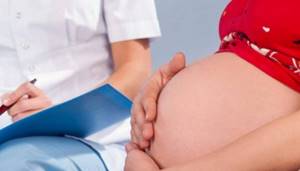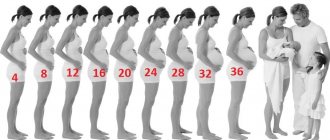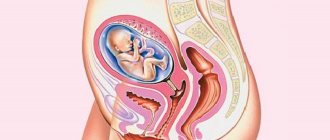First trimester.
There are two critical periods in the first trimester of pregnancy:
The first period is at 2-3 weeks of pregnancy.
It is at this time that the sperm fertilizes the egg, and it attaches to the wall of the uterus. The embryo may then stop developing (frozen pregnancy). Read on the topic: Frozen pregnancy: what it is, causes, signs.
Also, implantation may not occur for various reasons, and in this case the embryo dies and is released during menstruation; the woman during this period may not even suspect that she was pregnant.
The second period is at 8-12 weeks of pregnancy.
During this period, the placenta actively develops. Under the influence of unfavorable factors, disturbances in its formation and anomalies in its development may occur.
Causes of miscarriage during this period:
- a large amount of androgens are released;
- disruption of the thyroid gland and pituitary gland;
- decreased functioning of the corpus luteum of the ovaries.
Dangerous periods during pregnancy:
Dangerous weeks occur in every trimester.
- in the first trimester
There are three dangerous periods in the first trimester:
- 2-3 weeks - the period of implantation of the embryo into the uterus;
- 4-6 weeks - the period of formation of the rudiments of the baby’s future organs;
- Week 8-12 is the time when the placenta begins to form.
If a woman does not know about the pregnancy or has not prepared for it, safety measures are most likely not observed: the woman in labor may continue to exercise, be nervous, and take medications incompatible with pregnancy. There may also be untreated gynecological diseases, an unhealed scar after a cesarean section, which will prevent the fertilized egg from attaching to the wall of the uterus.
From the 4th to the 6th week of pregnancy, the main organs of the fetus begin to develop, and if the expectant mother is careless, the embryonic petals may be formed incorrectly, i.e. with pathologies. Often pathologies are incompatible with life, resulting in a miscarriage.
The third month of pregnancy (the time from the 8th to the 12th week) is characterized by the formation of the placenta - the baby’s main protective weapon. It is the placenta that protects the fetus in the womb from various unfavorable conditions. Its normal formation largely depends on the state of the endocrine system, therefore, if the thyroid gland is disrupted, excessive synthesis of progesterone or testosterone is often recorded, a frozen pregnancy is often recorded, followed by spontaneous termination.
More on the topic
Critical periods of pregnancy to remember!
What are the most dangerous days of pregnancy?
Blood after sex during pregnancy
Should I use a seat belt during pregnancy?
Contraction of the uterus during pregnancy
- in the second trimester
The middle of pregnancy also has its own dangerous period - the longest in all 9 months. It begins at the 18th week and lasts until the 22nd. If a miscarriage occurs during this period, it is called late, and the causes of spontaneous abortion are often:
- Incorrect location of the placenta;
- Hypertonicity of the uterus;
- Isthmic-cervical insufficiency;
- Venereal diseases.
Incorrect location of the placenta may be associated with its partial or complete presentation, low location, as well as the inability to be in the right place due to physical barriers (scars, fibroids and other neoplasms, congenital anomalies of the structure of the uterus). As a result, placental abruption can occur, and without medical intervention, this condition often ends in bleeding and fetal death.
Isthmic-cervical insufficiency (ICI) is associated with premature dilatation of the cervix due to muscle relaxation, which is caused by either the pressure of a large fetus or uterine hypertonicity. Although this condition is rare, it can cause premature birth.
Sexually transmitted infections pose a direct threat to the baby's life. Pathogens are able to penetrate the placenta and cause leakage of amniotic fluid. To avoid this, you need, firstly, to prepare for pregnancy and undergo examination at the planning stage, and secondly, to use barrier contraception when engaging in sexual activity during pregnancy.
- in the third trimester
By the beginning of the third trimester, the mother’s womb contains a fully formed human being with arms, legs and almost all organ systems. However, the baby is not yet ready to be born, because not all organs are able to function on their own (for example, the lungs), and the weight and height of the child are still too small for independent life. Therefore, premature birth, which often occurs from the 28th to the 32nd week, is fraught with mortal danger.
During the critical weeks of the final trimester, risk factors are:
- Preeclampsia, severe late toxicosis;
- ICN;
- Placental abruption;
- Polyhydramnios and oligohydramnios;
- Fetoplacental insufficiency;
- Hormonal disbalance.
Second trimester.
The third period is at 18-24 weeks of pregnancy. It is considered the “safest” and calmest period, during which the uterus, and with it the fetus, actively grows. However, miscarriage is possible during this period, and it can occur for the following reasons:
— ICI (isthmic-cervical insufficiency). As a result: the cervix dilates under pressure from the weight of the fetus and increased tone, which leads to premature birth;
— STIs that disrupt the functions of the placenta, resulting in breakthrough of amniotic fluid;
- pathology of the location of the placenta. As a result of placental abruption, severe internal bleeding occurs, resulting in fetal death.
What to watch out for: critical pregnancy periods
Many women wonder what are the important and dangerous moments of pregnancy after the IVF procedure. This should include the fact that after this procedure there is a possibility of giving birth to not one, but two children at once, which is very dangerous for the health of a pregnant woman.
Besides:
- There is a risk of miscarriage in the early stages;
- There is a possibility of genetic abnormalities occurring in the fetus;
- Possible placental abruption.
Rotavirus during pregnancy: 11 foods to avoid
It is important to know from how many months you should be wary and how to reduce the risks of spontaneous miscarriage. The first weeks of pregnancy are considered the most dangerous after the IVF procedure. This occurs due to the addition of eggs in a non-standard way, which leads to the fact that the immune system can reject the child, while producing antibodies. That is why, during this period, it is important to take special hormonal medications that prevent the possibility of miscarriage.
What is pregnancy
In the reproductive organs of a woman preparing to become a mother, the future baby grows and develops. First the embryo is called an embryo, then a fetus. The baby receives nutrition through the umbilical cord - a tube with veins and arteries that connects it to the placenta, a vascular sac. From the mother, the fetus receives blood saturated with oxygen and nutrients, and back -
with carbon dioxide and metabolic products.
How does it arise
Pregnancy occurs after successful conception. This process is possible during the period of ovulation, when a woman’s egg (oocyte) matures in one of the ovaries and begins its journey to the uterus. Sperm in a man's seminal fluid, entering a woman's vagina during sexual intercourse, strive to reach the egg. Male cells “loose” the surface of the oocyte, and the sperm, the first to reach the inner membrane, merges - fertilization of the egg occurs.
There is an opinion that if two sperm penetrate the oocyte, a multiple pregnancy will occur, but such an embryo is doomed to death. A fertilized egg into which only one sperm has implanted turns into a zygote. The future embryo does not stop, but continues to move down the fallopian tube in order to attach to the wall of the uterus, after which pregnancy occurs.
How long does it last
If the countdown starts from the moment of conception, the intrauterine life of the fetus will be 38 weeks. However, the pregnancy period is usually counted starting from the first day of the last menstruation. Then the pregnancy lasts 40 weeks or 10 obstetric months. This practice of counting is a consequence of the fact that it is not always possible to accurately determine the day of conception.
Last three months
Beautiful pregnant woman outdoors
The final stage begins from the 25th week and lasts until the birth itself, that is, until the 40th week of pregnancy. A significantly larger belly prevents a woman from walking and sleeping freely, and the added pounds can cause pain in the joints and lower back. The enlarged uterus puts pressure on the internal organs, causing shortness of breath, heartburn, and problems with digestion and urination. Physically, this period is the most difficult.
Features of the trimester
At the 28th week, the baby’s height is approximately 35 cm, and the weight is already 1100 g. However, he does not intend to stop there. The brain and nervous system continue to develop, and the senses improve. By the end of the third trimester, he can grow up to 50 cm and gain weight up to 3500 grams. The uterus gradually descends, and just before birth, the baby’s head also descends.
The greatest danger during this period is premature birth and the birth of a premature baby.
Dangerous Weeks

All the troubles associated with this period occur mainly in the 28th and 32nd weeks. It is at this time that premature birth can occur, caused by hormonal imbalances that provoke late toxicosis or cervical insufficiency.
One of the most dangerous complications of this period is placental abruption. Strictly speaking, this pathology can manifest itself in any trimester, but it is in the later stages, when all the compensatory capabilities of the body have already been exhausted, that it is most difficult. Any signs of detachment serve as a reason for emergency hospitalization. If the detachment occurs immediately before or during childbirth, then either stimulation of labor or a cesarean section is performed.
Another complication may be placental insufficiency, which arises due to previous infectious diseases. The development of this pathology causes disruption of the functions performed by the placenta. It stops supplying the baby with nutrients and oxygen, cannot cope with waste products and cannot protect the baby from adverse factors that can lead to termination of pregnancy.
Precautionary measures

Do not wait anxiously for the date prescribed by your doctor to approach. If your baby does not appear clearly on the appointed date, this does not mean that something went wrong. Avoid stressful situations, get plenty of rest, avoid long trips, and pay increased attention to any changes that appear in your body.
Starting from the 34th week, the born baby is considered completely healthy. Such termination of pregnancy, a little earlier than the term, as a rule, does not pose any danger. If the doctor discovers any of the conditions that threaten the health of the mother or baby, then the woman is placed on conservation care until the birth.
Maximum attention to yourself and timely contact with a doctor for advice or help will help you avoid most threatening factors. And waiting for the birth of a son or daughter will be pleasant and happy.
II trimester of pregnancy
In the second trimester of pregnancy, the placenta and fetus continue to grow. In this case, the formation and development of higher structures of the fetal brain, neuroendocrine, and autonomic nervous system occurs. The fetus develops protective and adaptive reactions. After 19-20 weeks, the intensity of uteroplacental and fetal placental blood flow increases. The function of the placenta provides for the increasing needs of the fetus.
The most typical complications of the second trimester of pregnancy are: threat of late spontaneous miscarriage, bleeding due to placental abruption, anemia, early forms of gestosis, intrauterine infection. These complications contribute to the formation of placental insufficiency and fetal growth retardation.
Due to the increasing size of the uterus, which begins to shift the abdominal organs towards the chest, shortness of breath and heartburn may begin to bother you after 15-16 weeks. The kidneys begin to experience significant stress.
In women with extragenital diseases (kidney disease, hypertension, neurocirculatory dystonia) from 20 weeks there is a risk of developing gestosis. In this regard, you should pay attention to the appearance of edema, excessive and uneven weight gain, increased blood pressure, and the appearance of protein in the urine.
Therefore, it is important to monitor the normal development of the fetus and the course of pregnancy, as well as prevent possible complications.
A pregnant woman should visit a doctor at least once a month, and in some situations, more often. At each visit, the doctor examines the patient, monitors weight gain, measures the circumference of the abdomen and the height of the uterine fundus above the womb, determines blood pressure, and listens to the fetal heartbeat. Prescribes the necessary additional studies.
At 20-24 weeks of pregnancy, a second mandatory ultrasound examination is performed, which is necessary to determine whether the size of the fetus corresponds to the expected period of pregnancy in order to exclude delayed fetal development; detection of fetal malformations; assessing the amount of amniotic fluid; studying the condition of the placenta. Also important is a Doppler study, which is performed during ultrasound to assess the intensity of uteroplacental and fetal placental blood flow.
In the second trimester of pregnancy, in the interval from 16 to 20 weeks, for prenatal screening of possible fetal anomalies, it is advisable to determine the blood level of a-fetoprotein (AFP), free estriol E3, inhibin-A and human chorionic gonadotropin (total hCG).
If there are no contraindications, then after 17 weeks you can begin to perform a special set of physical exercises for pregnant women, which allow you to control the muscles of the perineum and abdominals. It is also important to master breathing exercises.
It is advisable to start drug prophylaxis in pregnant women at risk already from 14-16 weeks of pregnancy under the supervision of a doctor. You should not self-medicate.
Let's sum it up
- According to statistics, obstetricians and gynecologists note a certain pattern in the frequency of dangerous weeks of pregnancy. It turns out that the most dangerous days for the health of mother and child during pregnancy are those days on which a woman would have had her period if she were not pregnant. Therefore, according to statistics, dangerous weeks occur every 3–4 weeks of each trimester.
- After reading the article, women planning a pregnancy may think that carrying a child is an endless danger of its loss or abnormal development of the fetus. In fact, pregnancy is a wonderful time when a woman gets to know her body and an unforgettable period of growing a new life. The main rule for preventing dangers is regular visits to the doctor and strict adherence to all his instructions. The sooner the expectant mother registers with the antenatal clinic, the more correct and safe her pregnancy will be. Dangerous weeks, after all, are called only periods during which mother and child become most vulnerable to the influence of external factors.
Expecting a baby is not only a pleasant, but also a very anxious time. Among the three trimesters, there are particularly dangerous periods where inattention to oneself and one’s health can end sadly for the expectant mother. To avoid this, you should carefully read each of the especially dangerous periods.
The word danger speaks for itself. A dangerous period of pregnancy if a woman does not pay proper attention to her condition can end very sadly. Any period of pregnancy has its own dangerous weeks, as well as the dangers that can await an inexperienced mother.
As a rule, this is precisely the time when life inside a woman develops extremely actively, namely, the formation of vital organs, the formation of the skeleton, and a special need for the female hormone progesterone or vitamins.
There are three periods of pregnancy, called trimesters. Each trimester has its own danger, those weeks in which the expectant mother requires maximum comfort and care. But we can highlight another one - in the first two weeks of pregnancy, when the fertilized egg is implanted into the uterus.
The period of danger itself, with an inappropriate approach, has an outcome such as miscarriage or frozen pregnancy. It is also possible to develop other pathologies that do not lead to the death of the fetus, but have an extremely negative impact on the health of the unborn child. In addition to all of the above, dangerous days include the days on which a woman was supposed to menstruate.
The danger of the first trimester of pregnancy awaits a pregnant woman at the very beginning. This period is truly dangerous because the woman is not yet aware of the birth of a new life within herself. This period occurs on days 10-21 of pregnancy.
The danger lies in the fact that the unsuspecting adheres to her usual rhythm of life, often with excessive physical exertion, and does not even know that colossal processes are taking place inside. At this moment, the fertilized egg tries to attach to the wall of the uterus in order to subsequently form a viable embryo.
Any sudden movements or overexertion can interfere with this process. In addition to external factors, implantation of the fertilized egg can also be hindered by internal ones, such as chromosomal and genetic abnormalities and cracks. The second dangerous period of the first trimester will be the beginning of the 8th week and until the end of the first trimester. At this time, sharp hormonal changes occur, which may be abnormal, as well as the growth of the placenta and the formation of vital organs in the unborn child.
The second trimester of pregnancy is rightfully considered golden and magical for expectant mothers. Somewhere from the middle of the trimester, you will begin to feel fetal movements, and you will also be able to find out the gender of the unborn child. Throughout the second trimester, the baby develops and grows very quickly.
The dangerous period is considered to be the time when the uterus rapidly grows in size.
- The time of active growth of the uterus begins at week 18 and lasts until the end of the second trimester (week 22). As a result, deviations from the normal course of pregnancy may occur:
- weakening of the cervix;
- incorrect location of the placenta;
- increased risk of all kinds of infectious diseases.
The end of the second trimester should be spent in complete peace and attentiveness to yourself. All of the above deviations can lead to miscarriage. If you feel the slightest pain, ailment or any other sensations that are not typical for your usual state, immediately go to the doctor. It is worth noting that very often expectant mothers spend the end of the second trimester in the hospital for preservation.
The third trimester is not only the finish line, but also the most difficult period. Premature births with fetal death are common here. The most dangerous period for the third trimester is from 28 to 32 weeks. Every woman knows what toxicosis is, but the danger that awaits you in the later stages of pregnancy is less common, we are talking about late gestosis.
- Late gestosis is much more exhausting than early toxicosis. The third trimester can cause such abnormalities as:
- placental abruption;
- premature aging of the placenta;
- lack of placenta.
There is one thing. Babies born in the third trimester very often survive (they are simply born premature) - this is a significant advantage over the first six months of pregnancy. It is worth recalling that in order to avoid sad consequences, strictly adhere to your doctor’s instructions and take special care of your health throughout the entire pregnancy.
Let’s not open America up and say it very simply: in order to prevent a critical situation, you need to do everything in a timely manner and according to the doctor’s instructions.
- Let's highlight together a number of simple actions that will help you protect the critical stages of pregnancy:
- firstly, minimal physical activity and sudden movements;
- we avoid even mental stress;
- abstinence from sexual activity;
- no stressful situations;
- maximally passive lifestyle (walks in the fresh air are possible).
If you follow such simple rules, which should actually be the basis of the entire period of waiting for your baby, they will help you prevent negative consequences.
Progression of pregnancy by week
Each stage of bearing a child has its own characteristic features that a woman should know about. Obstetricians divide pregnancy into trimesters of equal length.
In addition, there is a practice of dividing pregnancy into periods determined by one or another stage of fetal maturation: these are the pre-implantation, implantation periods, organogenesis and the fetal stage.
Pre-implantation period
From the moment of conception and the actual onset of the first stage of pregnancy, 6-7 days pass. The zygote, in which cell fragmentation occurs, moves along the fallopian tube. At this point, the embryo is a ball consisting of 200 cells, which is called a blastocyst. Having reached the uterus, the blastocyst is fixed on one of its walls. This period is called pre-implantation.
Implantation period
The inner surface of the uterus is covered with a special tissue - the endometrium, which thickens during implantation. Blastocyst cells are attached to the endometrium by special processes. At this moment, the future placenta secretes a special hormone - human chorionic gonadotropin, which, entering the ovaries, prevents the onset of menstruation. The presence of this substance in the body helps determine pregnancy using a test.
Organogenesis and placentation
After successful implantation of the fertilized egg, the embryo enters a process of organ formation called organogenesis. The so-called axial complex is formed: neural tube, notochord, intestine. In parallel with the formation of organs, tissues are formed - nervous, epithelial, connective, and muscle.
The latter serves as the basis for the heart, kidneys, genitals, and blood. Organogenesis is completed by the end of the fourth month.
In parallel with these processes, from the end of the second month, the formation of the placenta occurs. Until this moment, the chorion is determined in the embryo, which serves as the outer shell. With the development of the fertilized egg, villi appear in the chorion, which are gradually penetrated by vessels. Next, the chorion fuses with endometrial cells, and at 12-14 weeks the placenta forms in the uterine cavity.
Fetal period
From the 12th week until birth, the embryo is no longer considered an embryo, it is called a fetus. Obstetricians talk about the fetal or fetal period, in which, if there is a threat of miscarriage, they try to save the fetus. There are other critical periods of pregnancy, but the first danger is already over. By this time, the baby has already formed all the main organs and systems, he is growing rapidly, gaining weight and acquiring human characteristics.










